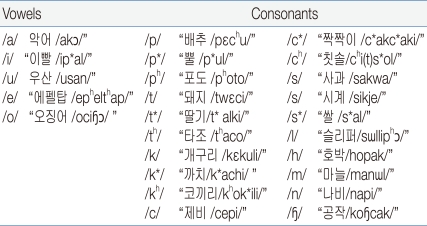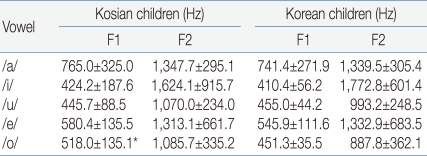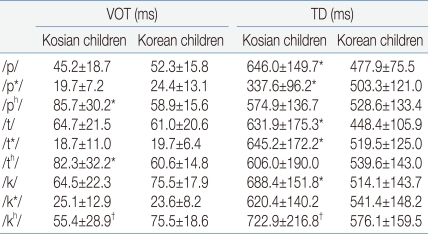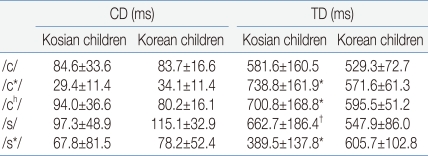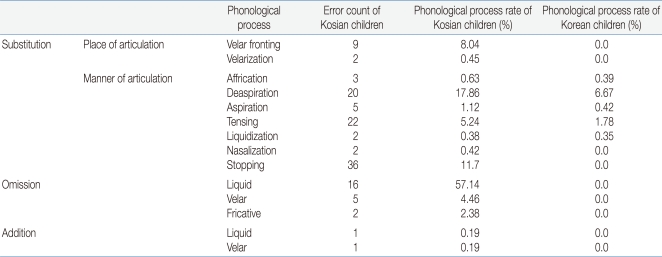All issues > Volume 53(9); 2010
Korean speech sound development in children from bilingual Japanese-Korean environments
- Corresponding author: Sun Jun Kim, MD. Department of Pediatrics, Chonbuk National University Medical School, 634-18, Keumamdong, Duckjinku, Jeonju 561-712, Korea. Tel: +82.63-250-1799, Fax: +82.63-250-1464, sunjun@jbnu.ac.kr
- Received April 09, 2010 Revised July 12, 2010 Accepted August 22, 2010
- Abstract
-
- Purpose
- Purpose
- This study investigates Korean speech sound development, including articulatory error patterns, among the Japanese-Korean children whose mothers are Japanese immigrants to Korea.
- Methods
- Methods
- The subjects were 28 Japanese-Korean children with normal development born to Japanese women immigrants who lived in Jeonbuk province, Korea. They were assessed through Computerized Speech Lab 4500. The control group consisted of 15 Korean children who lived in the same area.
- Results
- Results
- The values of the voice onset time of consonants /ph/, /t/, /th/, and /k*/ among the children were prolonged. The children replaced the lenis sounds with aspirated or fortis sounds rather than replacing the fortis sounds with lenis or aspirated sounds, which are typical among Japanese immigrants. The children showed numerous articulatory errors for /c/ and /l/ sounds (similar to Koreans) rather than errors on /p/ sounds, which are more frequent among Japanese immigrants. The vowel formants of the children showed a significantly prolonged vowel /o/ as compared to that of Korean children (P<0.05). The Japanese immigrants and their children showed a similar substitution /n/ for /ɧ/ [Japanese immigrants (62.5%) vs Japanese-Korean children (14.3%)], which is rarely seen among Koreans.
- Conclusion
- Conclusion
- The findings suggest that Korean speech sound development among Japanese-Korean children is influenced not only by the Korean language environment but also by their maternal language. Therefore, appropriate language education programs may be warranted not only or immigrant women but also for their children.
- Introduction
- Introduction
International marriages between provincial Korean bachelors and Asian women (who frequently consider the marriage as a way to immigrate to Korea, occasionally after just an international "blind date") have been increasing because of religious or economic reasons. The number of international marriages was only 4,710 in 1990, but it has been increasing; international marriage has occupied more than 11.1% of all marriages (43,121 in 2005 and 38,491 in 2007) in Korea1). Recently, social problems have been increasing due to these unprepared international marriages. These problems have been caused by the abrupt, unprepared nature of the marriages due to the mutual lack of social, cultural, and linguistic understanding. Most bachelors live in rural communities and are not fully ready for a marriage, both socially and economically2). Moreover, Korea is a country that is traditionally relatively conservative with regard to other nationalities and still needs to establish adequate social and educational systems for assisting less prepared immigrants such as foreign brides. This situation could cause many problems such as family deconstruction by cultural difference, communication, social adaptation, and childcare by exposing the immigrants and their children to cultural and linguistic fragilities (also known as Kosian)1, 3, 4).We analyzed the development and articulation error in Korean language usage among Japanese women immigrants (who came mainly for religious reasons) who have a relatively longer immigration history than other nationalities5). According to the preceding study by the authors, Japanese immigrants showed Korean pronunciation errors on vowels such as /e/, /a/, /u/, /o/, /ε/, and /ω/ and also showed errors on consonants such as the replacement of lenis or fortis sounds, because the ability to discriminate fortis sounds from aspirated sounds has been reduced.This study compares the articulation development and characteristics by comparing the articulation development among the Japanese-Korean children under Japanese immigrant mothers with that of Korean children under Korean mothers.
- Materials and methods
- Materials and methods
- 1. Voice sample
- 1. Voice sample
The data set for this study included twenty-eight children who lived in Sunchang district, Jeonbuk province with Korean fathers and Japanese mothers. There were 15 boys and 13 girls; all were more than 5 years old (mean±SD, 8.2±2.3 years).The control group was 15 Korean children who showed normal development. They lived in the same area and had Korean parents; they were in the same age group.- 2. Voice Recording
- 2. Voice Recording
Similar to the method used in a previous study6) by the authors, voice recording was done by Digital Audio Tape (DAT) recorder (TC-D10/TC-D10 Pro, Sony, Tokyo, Japan) and saved by Computerized Speech Lab (CSL) after conversion. The sampling rate was 11,025 Hz.In a quiet environment, the children were asked to say /ah-/, which makes the negative pressure UV level turn off. Then, recordings began after the children enunciated the investigating dates and their hometowns. The children were recorded with Shure SM48 microphone (Shure Incorporated, Niles, IL, USA) at a distance of approximately 10-15 cm from the mouth, and the recordings were directly stored into the host computer.- 3. Experimental Method
- 3. Experimental Method
1) Vowels
1) Vowels
For Vowel analysis, Formant 1 and Formant 2 were measured after selecting spectrogram on Fast Fourier Transform (FFT) window of CSL, and the analysis option was set at 100 point.Formant 1 (F1) and Formant 2 (F2) were measured for low front unrounded vowel /a/, high front unrounded vowel /i/, high back rounded vowel /u/, mid front unrounded vowel /e/, and high back rounded vowel /o/.2) Consonants
2) Consonants
Voice onset time (VOT), Consonant Duration (CD), and total duration (TD) were measured for bilabial stop /p/, /p*/, /ph/, alveolar stop /t/, /t*/, /th/, velar stop /k/, /k*/, /kh/, alveolopalatal affricate /c/, /c*/, /ch/, and alveolar fricative /s/, /s*/. The values were compared with those of the control group.3) Articulation and phonological error
3) Articulation and phonological error
In addition to the voice analysis, we evaluated the articulation error of the Kosian children in sound and calculated the phonological process occurrence.For the phonological process, all of the following were compared between the Korean and Kosian children. For the substitution by the place of articulation, velar fronting and velarization were compared. For the substitution by the manner of articulation, affrication, deaspiration, aspiration, tensing, liquidization, nasalization, and stopping were compared. For the omission process, liquid omission, velar omission, and fricative omission were compared with each other. For the addition process, liquid addition and velar addition were compared.
From the Velopharyngeal Insufficiency (VPI) Articulation discrimination test (by Shin HK & Kim HG, 2003), 5 vowels (/a/, /i/, /u/, /e/, /o/) and consonants were selected as the experimental method to analyze the children's voice (Table 1).- 4. Statistics
- 4. Statistics
The statistical values of mean and standard deviation were obtained through the SPSS 12.0 program. After executing independent t-test, p-values were defined as statistically significant when P<0.01 or P<0.05.
- Results
- Results
- 1. Vowel analysis
- 1. Vowel analysis
The F1 value of the Kosian children in high back rounded vowel /o/ was higher than that of the Korean children with a 66.7 Hz difference (518.0±135.1 Hz vs 451.3±35.5 Hz, P<0.05, Table 2). The F2 value of /o/ for the Kosian children was also higher than that of the Korean children with a 197.7 Hz difference (1,085.7±335.2 Hz vs. 887.7±362.1 Hz, P=0.08, Table 2). The F1 and F2 values of front unrounded vowel /a/, for the Kosian children were 765.0±325.0 Hz and 1,347.7±295.1 Hz, respectively, which were higher (but statistically insignificant) than those of the Korean children (741.4±271.9 Hz, 1,339.5±305.4 Hz). In particular, the F1 of high back rounded vowel /u/ for the Kosian children showed a slightly lower result than that of the Korean children (445.7±88.5 Hz vs 455.0±44.2 Hz, P>0.05). In the F2 values of vowel /e/, the Kosian children had a higher value than the Korean children; in the values of /i/ and /u/, the Kosian children tested lower than the Korean children. However, none of these results were statistically significant (P>0.05, Table 2).- 2. Consonant analysis
- 2. Consonant analysis
1) Plosives
1) Plosives
The values of VOT and TD for Plosives were significantly different between the Kosian and Korean children, especially in the aspirated sound (P<0.01, Table 3). In the aspirated sound /ph/ of bilabial stop (Kosian vs. Korean=85.7±30.2 ms vs 58.9±15.6 ms) and the aspirated sound /th/ of alveolar stop (82.3±32.2 ms vs 60.6±14.8 ms), the VOT values of the Kosian children were longer than the Korean children's (P<0.01, Table 3). However, for the aspirated sound /kh/ of velar stop, the Kosian children had a shorter value than the Korean children (55.4±28.9 vs 75.5±18.6 ms, P<0.05).Also, significant differences were found in the TD of stop consonants between the Kosian and Korean children. Significant differences were found in the lenis sound /p/ and the fortis sound /p*/ for bilabial stop (P<0.01), the lenis sound /t/ and the fortis sound /t*/ for alveolar stop (P<0.01), and the lenis sound /k/ and the aspirated sound /kh/ for velar stop sound (P<0.01, P<0.05). The TD values of the Kosian children with the exception of /p/ sound were somewhat higher than the Korean children's (Table 3).2) Affricates
2) Affricates
In the case of the Consonant Duration (CD) of alveolopalatal affricate, all were not statistically significant (P>0.05, Table 4). With regard to the comparison of the TD of alveolopalatal affricate between the two groups, the TD of the Kosian and Korean children were significant different for the fortis sound /c*/ and the aspirated sound /ch/ (P<0.01). For all phonemes, the TD of the Kosian children was longer than the TD of the Korean children (Table 4).3) Fricatives
3) Fricatives
For the CD of fricatives, the lenis sound /s/ and the fortis sound /s*/ of the Kosian children were shorter than those of the Korean children, but there were no statistically significant differences (Table 4). Significant differences were found in the TD of stop consonants between the Kosian and Korean children. In the lenis sound /s/ values, the Kosian children had longer value than the Korean children (P<0.05), whereas the value of the fortis sound /s*/ of the Kosian children was shorter than that of the Korean children (P<0.01, Table 4).
- 3. Articulation and phonological error patterns
- 3. Articulation and phonological error patterns
1) Phonological Process Patterns
1) Phonological Process Patterns
Velar fronting were significantly higher among the Kosian children than the Korean children (P<0.05, Table 5). The Kosian children showed 8.04% (9/112) error rate, which was similar with the normal 3-4 year-old Korean children. A number of the Kosian children substituted the velar stop /k/ for /t/ and velar nasal /ɧ/ for /n/. Of the articulation patterns by substitution, velarization was extinguished for the Korean children, whereas 2/448 (0.45%) of the Kosian children showed errors (i.e., substituted /p/ for /k/). The affrication of both groups was recorded with a low frequency of occurrence, and fricative /s/ and /s*/ were mainly substituted for affricate /c*/. For deaspiration, the error rate of the Kosian children was 20/112 (17.86%) and that of the Korean children was 4/60 (6.67%). The Kosian children showed more errors than the Korean children. The Kosian children substituted /ch/ with /c*/ for alveolopalatal affricate, /ph/ with /p*/ and /p/ for bilabial stop, and /kh/ with /k*/ for velar stop. Aspiration was recorded with an error of 1/240 (0.42%) among the Korean children but was observed in 5/448 (1.12%) for the Kosian children. The fricative /s/ was deaspirated to /th/. Also, the alveolar stop /t/ was deaspirated to /th/, and the velar sound /kh/ was deaspirated to /k*/. Tensing was also found to occur more frequently among the Kosian children. The alveola fricative /s/, the alveolopalatal affricative /c/, the bilabial stop /ph/, and the velar stop /kh/ were tensed. Liquidization was not significantly different between the two groups, but the nasal /n/ and the alveolar stop /t/ were liquidized among the Kosian group. Both groups were recorded with a low occurrence of error for nasalization, but the Kosian children showed errors in substituting the velar stop /k/ and the liquid /l/ for /ɧ/. Stopping was recorded with a high frequency of occurrence for the Kosian children. Also, the alveolopalatal affricates /c/, /c*/, and /ch/ were substituted for /t/, /t*/, and /th/, respectively, and the fricatives /s/ and /s*/ were substituted for /t/ and /t*/ or /th/ (Table 5).The omission process was observed with a high frequency of occurrence for the Kosian group, especially in the omission of liquid. Although addition process was not significantly different between the two groups, the velar stop /k/ and the liquid /l/ were added in the Kosian group (Table 5).2) Articulation error
2) Articulation error
Articulation error was analyzed by the occurrence of the articulation errors among the Kosian and Korean children. The analysis was divided into substitution, distortion, omission, and addition (Table 6).For the Kosian children, the substitution was 76/616 (12.3%), the omission was 23/616 (3.7%), the distortion was 19/616 (3.1%), and the addition was 0.3%. The total error rate was 120/616 (19.5%). On the other hand, the substitution for the Korean children was 7/300 (2.3%), the distortion was 0/300, the omission was 0/300, and the addition was 0/300. The total error rate of the Korean children was 7/300 (2.3%). With respect to the articulation error, the Kosian children showed many more errors. The Kosian children exhibited a particularly higher rate of substitution than the Korean children (Table 6).
- Discussion
- Discussion
With respect to the vowel formant results of the Kosian and Korean children, the F1: 518±135.1 of /o/ of the Kosian children was significantly higher than the F1: 451.3±35.5 of the Korean children (P<0.05). This indicates that the Kosian children's sound is located in more open and lower position. Also, the F2: 1085.7±335.2 for the Kosian children was higher than the F2: 887.7±362.1 for the Korean children (P<0.10). This is a significant result, and it is related to the Japanese language characteristics where the lip is not rounded, pursed, and protruded outwards in comparison with the Korean language7). For rounded vowels, the F2 value was lower, but the F2 value was higher for less rounded vowels.The findings correspond to the Japanese women immigrants' vowel formant analysis results by Jo et al.5). The Kosian children are affected by their mothers' pronunciation. However, Japanese women immigrants showed significant results in the F1 of /e/, the F1 of /a/, and the F2 of /u/, but the Kosian children did not show such results. Korean consonants are different from western languages' double contrast framework, because they consist of triple contrast8, 9). The Korean language is divided by lenis sounds, aspirated sounds, and fortis sounds. From the acoustic aspect, these sounds are discriminated by the VOT length. The VOT length is prolonged as glottis is more open at stop sound9, 10).Korean consonants are discriminated by lenis sounds, aspirated sounds, and fortis sounds, but Japanese sounds are discriminated by voiced and voiceless sounds11, 12). In Japanese language, for voiced and voiceless, bilabial stop is discriminated by /b/ and /p/; alveolar stop by /e/ and /t/; velar stop by /g/ and /k/; and fricative by /s/ and /z/10-12). In contrast, Korean consonants are discriminated by the bilabial stops /p/, /p*/, and /ph/; alveolar stop by /t/, /t*/ and /th/; velar stop by /k/, /k*/, and /kh/; alveolopalatal affricate by /c/, /c*/, and /ch/; and alveolar fricative by /s/, /s*/, and /∫/ 8, 9).Of the VOT values of the Kosian children, the aspirated sounds /ph/, /th/, and /kh/ showed significant difference from the Korean children. This suggests a substitution from aspirated sounds to lenis or fortis sounds. The prolonged VOT at /ph/, /th/ among the Kosian children are correlated with the results of a previous adult study5) by the authors.The results of the fricative /s/ and /s*/ among the Kosian children were also significantly shorter than the Korean children's. This suggests that the fricatives of the Kosian children are substituted for alveolar stop. The Kosian children showed frequent articulation error, even at a school age.The TD of the Kosian children was prolonged for all phonemes except /p*/ and /s*/. The increase in TD indicates a decrease in speaking fluency. This suggests that Kosian children are less fluent in comparison to Korean children13).The VOT and CD results showed a significant common difference in /ph/, /th/, /kh/, and /ch/ among the Japanese and Korean women and the Kosian and Korean children studied. However, the patterns of the increases and the decreases were not similar. For the Japanese women, articulation errors were shown, such as substituting lenis sounds or aspirated sounds for fortis sounds. Therefore, the VOT of fortis sounds were longer than those of the Korean women, but the children did not show these characteristics. The articulation error among the Kosian children was in substituting aspirated and fortis sounds for lenis sounds. The phonemes presenting the articulation errors were also different. The most common error among the Japanese women was the /p/ affiliate; the most common error among the Kosian children was the /c/ affiliate. A commonly mistaken phoneme was /l/. The substitution of /ɧ/ (→/n/) was also a common error, but the error rate was higher for the Japanese women (62.5%) than for the Kosian children (14.3%).In this study, we compared the phonological process, the occurrence among the Kosian and Korean children for omission, addition, and substitution, which was significantly different between groups. With respect to the articulation error, the Kosian children showed many more errors, particularly higher rates of substitution and omission than the Korean children.With respect to the phonological process patterns, the Kosian children showed a higher phonological process occurrence than the Korean children in the fronting of velar, aspiration, and deaspiration. These suggest a discrimination of aspirated sound and liquid, which do not exist in the Japanese language. Also, the distortion of liquid was the most common articulation error pattern, possibly influenced by the Japanese mothers.The following summarizes the results of this study: First, with respect to formant, the F1 and F2 of the Japanese women and the Kosian children were significantly higher than those of the Korean children and the Korean women for the vowel /o/. For the vowels /a/, /i/, /u/, and /e/, the Korean and Kosian children showed similar values, but the Japanese women had lower values for all formants except for the F2 of the vowel /u/. Second, with respect to VOT, CD, and TD, the resulting data for the Kosian children and the Japanese women were statistically different from those of the Korean children and the Korean women for the fortis sounds /ph/, /th/, and /kh/ of consonants. However, the increases in values and the patterns of decreases were not similar. For the Japanese women, articulation errors such as the substitution of fortis sounds or lenis sounds for aspirated sounds was shown, resulting in the prolonging of the VOT of fortis sounds, but the Kosian children did not show these characteristics. The articulation error among the Japanese women was chiefly the substitution of lenis sounds and aspirated sounds for fortis sounds. On the other hand, the articulation error among the Kosian children was mainly the substitution of fortis sounds and aspirated sounds to lenis sounds. The phoneme of articulation error was also different. The Japanese women showed the most errors on the /p/ affiliates, but the Kosian children had the most errors on the /c/ affiliates. The phoneme that had common errors was /l/. The substitution of /ɧ/ to /n/ was also a common error, but the error rate among the Japanese women (62.5%) was higher than that of the Kosian children (14.3%). Third, the Kosian children showed a very high rate of error on fronting, aspiration, deaspiration, affrication, the stopping of affricate, and liquid omission. Also, the Kosian children had difficulty in the discrimination of fortis sounds and liquid sounds and in the enunciation of liquid sounds.Japanese immigrants, who came to Korean mainly for religious reasons, are the subject of this study. These immigrants have relatively less economic problems in comparison with the immigrants (by marriage) from other countries; they also have characteristics similar to Koreans. Regardless, the results of this study suggest that the second generation Japanese-Koreans have been experiencing linguistic problems. Therefore, appropriate language education programs may be warranted not only for immigrant women but also for the second generation. This study is expected to contribute to the development of multicultural education programs for Kosian children.
- References
- 1. Hwang SS, Kim WS. A study on the phonological process patterns of children with articulation and phonological problems from multicultural families in agricultural areas. J Spec Educ: Theory Practice 2008;9:329–348.2. Hwang SS, Jeong OR. Language characteristics of children from culturally diverse family environments. Korean J Commun Disord 2008;13:174–192.3. Kwon MJ, Park SH, Seok DI. Articulation characteristics of preschool children in the bilingual environment. Speech Sci 2007;14:73–87.4. Yoo HY, Kim HH, Kim WS, Shin JC. Articulation ability and phonological process in multicultural family children. Speech Sci 2008;15:133–144.5. Jo SH, Kim HG, Kim SJ. Acoustic Characteristics of Korean Spoken by the Women Immigrants from Japan and Philippine. Speech Sci 2007;15:203–217.6. Park JI, Kim SJ, Kim HG. Acoustic effects of carbamazepine in benign rolandic epilepsy. Epilepsy Behav 2005;7:468–471.
[Article] [PubMed]7. Cho SM. An Acoustic Study of the Pronunciation of Korean Vowels Uttered by Japanese Speakers. Speech Sci 2004;11:69–81.8. Kim YT. A study of phonological regression in 2-6 years of Korean children. Malsori 1992;21:3–24.9. Kim HG, Lee EY, Hong KW. Experimental phonetic study of Kyungsang and Cholla dialect using power spectrum and laryngeal fiberscope. Speech Sci 2002;9:25–43.10. Carol AF, Valery S, David JO, Sarah AR, Pierre H. Cross language phonetic influences on the speech of French-English bilinguals. J Phon 2008;36:649–663.
[Article] [PubMed] [PMC]11. Timothy JR, Naoyuki T, Kaori O, Yoko U. The intermediate degree of VOT in Japanese initial voiceless stops. J Phon 2007;35:439–443.
[Article]12. Park YS. Korean Language Education and Bilingualism in Japan: The Fundamentals of Bilingual Education and the Needs for International Korean Language Promotion. Biling Res 2005;29:11–23.13. Lee SJ, Hwang MN. The Trade-off Effects between MLU and Fluency in Normal Preschool-age Children. Speech Sci 2001;8:157–168.

 About
About Browse articles
Browse articles For contributors
For contributors

